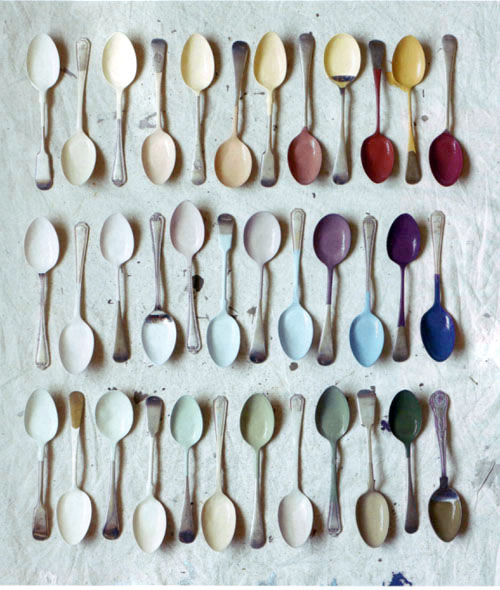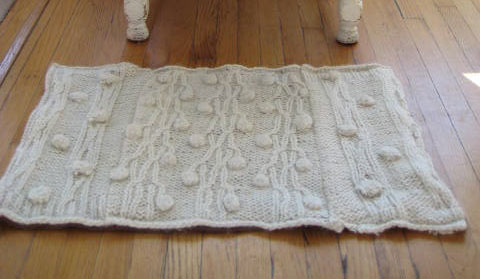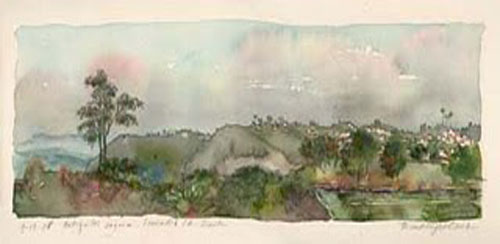 It would be a cinch if one could taste test paint to see which color was the yummiest. One thing we do know is that all that delicious color equals power - the power to transform a home. Color is as close as you can get to an instant personality makeover or wardrobe change for your home. It’s an inexpensive design tool that can elevate a mood, make a workspace more productive, energize a cooking area, add sexiness to a bedroom, be a dramatic backdrop for art, or just set a calm tone for living. All that power comes from a can of paint. In the past, this elemental powerhouse has failed in one major area—its environmental healthfulness.
I was standing in the paint department of my local hardware store (Williams Lumber) with paint chips and fabric swatches in hand in preparation of painting the main living spaces of my home (living room, dining room and hall.) While contemplating the overwhelming color selection, I'm thinking, “How do I want the space to feel and which color do I choose?” Well, I want it to feel cheerfully neutral. According to a very reputable source (the guy behind the paint counter), DIY interior painting is easy, but selecting a type of paint and paint color can be mind-numbingly difficult. He said, “People get dizzy looking at all the color choices. Try the new eco-friendly paints - they cover just as well as the regular paint.”
It would be a cinch if one could taste test paint to see which color was the yummiest. One thing we do know is that all that delicious color equals power - the power to transform a home. Color is as close as you can get to an instant personality makeover or wardrobe change for your home. It’s an inexpensive design tool that can elevate a mood, make a workspace more productive, energize a cooking area, add sexiness to a bedroom, be a dramatic backdrop for art, or just set a calm tone for living. All that power comes from a can of paint. In the past, this elemental powerhouse has failed in one major area—its environmental healthfulness.
I was standing in the paint department of my local hardware store (Williams Lumber) with paint chips and fabric swatches in hand in preparation of painting the main living spaces of my home (living room, dining room and hall.) While contemplating the overwhelming color selection, I'm thinking, “How do I want the space to feel and which color do I choose?” Well, I want it to feel cheerfully neutral. According to a very reputable source (the guy behind the paint counter), DIY interior painting is easy, but selecting a type of paint and paint color can be mind-numbingly difficult. He said, “People get dizzy looking at all the color choices. Try the new eco-friendly paints - they cover just as well as the regular paint.”
I wrote an article about eco-friendly paint, and we had already greened up a few painting projects. The health benefits for my family and the environment were enough reason to choose no-VOC eco-friendly paints in the two bathrooms we recently renovated. Since one small bathroom is particularly prone to mold and mildew, we used an earth-based natural wall finish, American Clay. We also had great results in the other bathroom with Aura Paint from Benjamin Moore.
 How do you choose a color from all of those “dizzying” choices? It seems the paint companies are trying to make the answer to that question easier with free color apps. Just snap a picture and you can instantly match it to one of thousands of hues in the color app systems. Benjamin Moore and Sherwin-Williams provide coordinating color palettes for your inspiration. If you don’t have an iPhone (like me), take a cue from these apps and bring a photo to the paint counter with you when you choose colors.
How do you choose a color from all of those “dizzying” choices? It seems the paint companies are trying to make the answer to that question easier with free color apps. Just snap a picture and you can instantly match it to one of thousands of hues in the color app systems. Benjamin Moore and Sherwin-Williams provide coordinating color palettes for your inspiration. If you don’t have an iPhone (like me), take a cue from these apps and bring a photo to the paint counter with you when you choose colors.
How much paint to buy? Measure twice, paint once. Here’s a handy paint calculator to help determine how much paint will cover a space. With DIY projects like painting a room, you don't want to make a costly mistake. You'll want to get it right the first time. Most paint companies provide coverage estimates on the paint can label.
I'm still in the process of sampling Aura and Natura paint colors. My wall looks like a tasty patchwork quilt, but I'm determined to get it right. I would love to know how you choose a paint color?
Credits: Main Image via Happy Mundane, iPhone, Drawing – Michael Maslin








